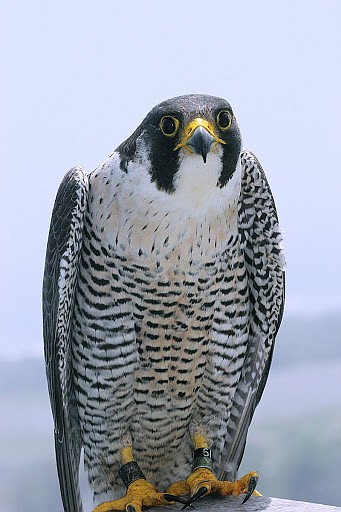CONSERVATION SUCCESS STORIES: Peregrine Falcon
Christian Ryan Correspondent | Hagadone News Network | UPDATED 5 years, 8 months AGO
Is it a bird? Is it a plane? Is it Superman? Well, this time it actually is a bird, the peregrine falcon (Falco peregrinus) to be precise. Though it looks like its close cousins, hawks and eagles, this raptor, or bird of prey, is a great deal smaller than the average hawk or eagle, measuring three and a half feet from one wingtip to the other and weighing up to three pounds.
This animal is not only the State Bird of Prey of Idaho, but it’s also the fastest bird on the planet. When they fold their wings to the sides and dive down through the air, they can reach well over 200 mph. They use this incredible speed to snatch unsuspecting prey in their talons. Unfortunately, the peregrine falcon’s speed wasn’t enough to keep it off of the endangered species list.
In the mid-20th century, people began to notice a sharp decrease in the population count among many species of birds. These included the brown pelican, bald eagle, osprey, and of course, the peregrine falcon.
Unlike the other animals we’ve talked about so far this summer, there were no mass killings of these birds to anyone’s knowledge, so overhunting couldn’t be the culprit. This encouraged individuals who were concerned about the birds’ well-being to investigate further. The surprise was that peregrine falcons and other birds were being taken out long before they were even born. The problem was a pesticide called Dichloro-diphenyltrichloroethane … or DDT for short. DDT is an almost tasteless and colorless chemical compound created by Austrian chemist Othmar Zeidler in 1874. Swiss chemist Paul Hermann Muller realized its potential as a powerful bug killer in 1939, and everyone wanted to use it to keep pesky critters off their crops. How could a pesticide designed for killing insects almost wipe out the peregrine falcon, especially since the falcon doesn’t eat insects?
The insects poisoned with DDT were easy prey for larger animals like robins and other small birds, rats, mice, creatures peregrine falcons love to eat. Each member of the food chain passed the toxin along to the animal that ate it.
Thankfully, peregrine falcons didn’t die from DDT directly, but it did affect their eggs. The eggs laid by DDT-carrying falcons had much thinner shells, so when the mother bird tried to sit on the nest, the eggs would crack open. With fewer peregrine falcons being born, their numbers started to get dangerously low and resulted in the extinction of this species in some areas, like the eastern United States. When conservation groups signaled the alarm, the government placed the peregrine falcon on the Endangered Species List in 1970.
The first step was obvious: DDT was banned. The second step was to ensure that peregrine falcons could be raised to adulthood in a safe environment. To do this, many of these birds were raised in captivity. One successful method conservationists used was to feed and tend to the chicks using a hand puppet that looked like a peregrine falcon head. This way, the birds would imprint on a “falcon” instead of its human caretakers. After they were old enough, the grown-up chicks were released into the wild.
By 1999, the peregrine falcon was doing so well that it was removed from the Endangered Species List. They also had spread back into the eastern United States, where they had all but died out. Bald eagles and other birds affected by DDT experienced similar recovery.
Rodents and smaller birds beware: the peregrine falcon is at large and on the hunt!
•••
Christian Ryan can be reached at animaladventures1314@gmail.com
MORE IMPORTED STORIES
ARTICLES BY CHRISTIAN RYAN CORRESPONDENT

Critters of North Idaho: American Coot
If you see this bird swimming across the water’s surface from a distance, chances are you will mistake it for a duck.

Critters of North Idaho: Northern pike
When we talk about human disturbance of the environment, we usually think of the overharvesting of trees, overhunting and littering. But we can also disrupt the natural balance by introducing species of animals and plants into non-native habitats. This is what happened in the case of the northern pike.

Critters of North Idaho: Ye ol' vole
If you see a little rodent scurrying about in the thicket or under the snow, you may think it’s a mouse. And it may be a mouse, but at first glance it is very difficult to tell a mouse apart from another little rodent, the vole. So difficult, in fact, that voles are often mistakenly referred to as “field mice.” What makes these little scurriers so different from each other? For starters, they belong to different families.






